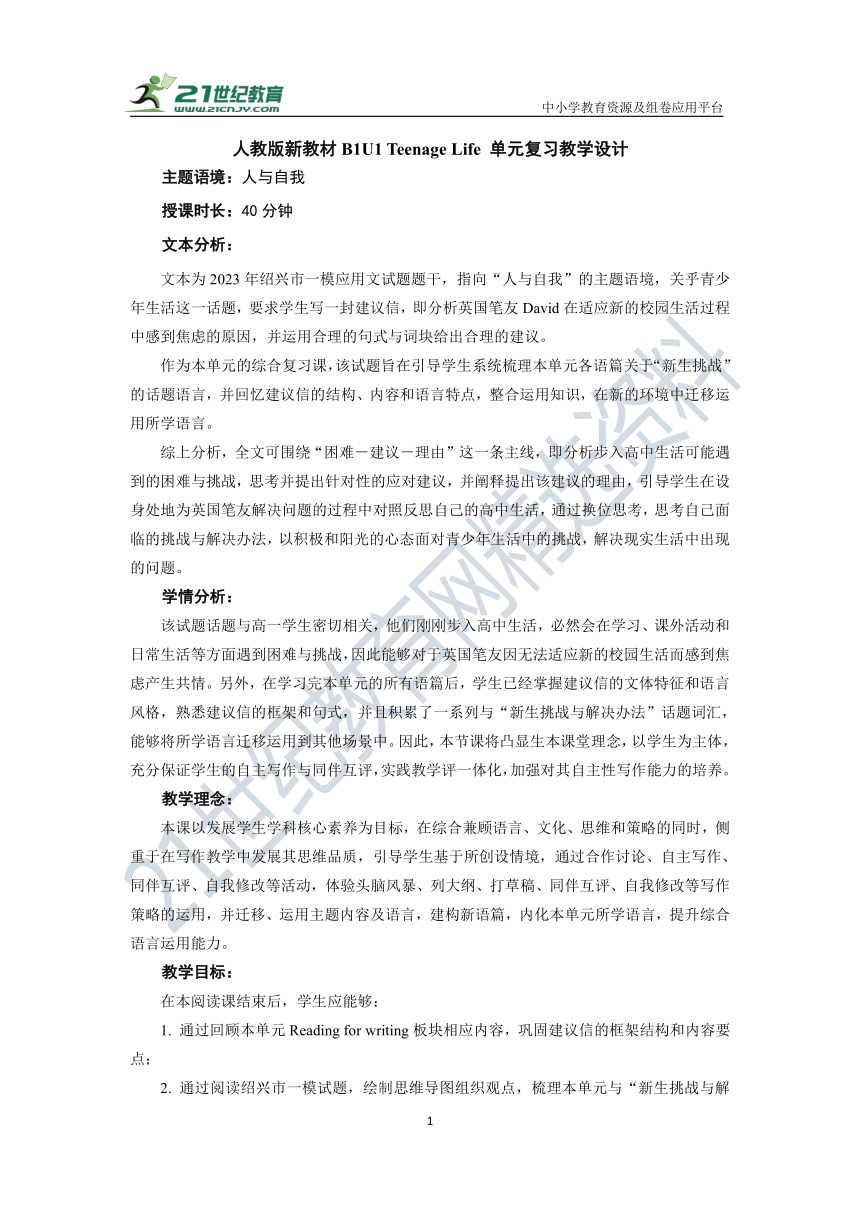人教版(2019)必修第一册 Unit 1 Teenage life 单元复习教学设计(表格式)
文档属性
| 名称 | 人教版(2019)必修第一册 Unit 1 Teenage life 单元复习教学设计(表格式) |  | |
| 格式 | docx | ||
| 文件大小 | 160.7KB | ||
| 资源类型 | 教案 | ||
| 版本资源 | 人教版(2019) | ||
| 科目 | 英语 | ||
| 更新时间 | 2024-09-21 12:18:21 | ||
图片预览


文档简介
中小学教育资源及组卷应用平台
人教版新教材B1U1 Teenage Life 单元复习教学设计
主题语境:人与自我
授课时长:40分钟
文本分析:
文本为2023年绍兴市一模应用文试题题干,指向“人与自我”的主题语境,关乎青少年生活这一话题,要求学生写一封建议信,即分析英国笔友David在适应新的校园生活过程中感到焦虑的原因,并运用合理的句式与词块给出合理的建议。
作为本单元的综合复习课,该试题旨在引导学生系统梳理本单元各语篇关于“新生挑战”的话题语言,并回忆建议信的结构、内容和语言特点,整合运用知识,在新的环境中迁移运用所学语言。
综上分析,全文可围绕“困难-建议-理由”这一条主线,即分析步入高中生活可能遇到的困难与挑战,思考并提出针对性的应对建议,并阐释提出该建议的理由,引导学生在设身处地为英国笔友解决问题的过程中对照反思自己的高中生活,通过换位思考,思考自己面临的挑战与解决办法,以积极和阳光的心态面对青少年生活中的挑战,解决现实生活中出现的问题。
学情分析:
该试题话题与高一学生密切相关,他们刚刚步入高中生活,必然会在学习、课外活动和日常生活等方面遇到困难与挑战,因此能够对于英国笔友因无法适应新的校园生活而感到焦虑产生共情。另外,在学习完本单元的所有语篇后,学生已经掌握建议信的文体特征和语言风格,熟悉建议信的框架和句式,并且积累了一系列与“新生挑战与解决办法”话题词汇,能够将所学语言迁移运用到其他场景中。因此,本节课将凸显生本课堂理念,以学生为主体,充分保证学生的自主写作与同伴互评,实践教学评一体化,加强对其自主性写作能力的培养。
教学理念:
本课以发展学生学科核心素养为目标,在综合兼顾语言、文化、思维和策略的同时,侧重于在写作教学中发展其思维品质,引导学生基于所创设情境,通过合作讨论、自主写作、同伴互评、自我修改等活动,体验头脑风暴、列大纲、打草稿、同伴互评、自我修改等写作策略的运用,并迁移、运用主题内容及语言,建构新语篇,内化本单元所学语言,提升综合语言运用能力。
教学目标:
在本阅读课结束后,学生应能够:
通过回顾本单元Reading for writing板块相应内容,巩固建议信的框架结构和内容要点;
通过阅读绍兴市一模试题,绘制思维导图组织观点,梳理本单元与“新生挑战与解决办法”相关的话题语言;
通过分析英国笔友可能遇到的挑战并给出合理的建议,写一封建议信,对照反思自身适应高中新生活的情况,勇于面对困难与挑战;
通过根据写作评价标准对他人的文章给出合理、有逻辑的建议,培养自我修正意识,实现有效交流和共同进步。
教学重点:
帮助学习回顾梳理建议信的常见结构和语言特征,整合“青少年生活”主题统领下“新生挑战”相关话题语言,并能写出一封内容全面、语义全面、结构清晰的建议信,并对他人的文章给出合理、有逻辑的建议。
教学步骤:
教学步骤 教学活动 设计意图 互动时间&模式
写前阶段(Pre-writing)
Step 1 Lead-in Ss pay attention to the instructions of the practical writing and think about the following question: Q: What are the stylistic features of a letter of advice (e.g. structure, content and language) Ss review the text from B1U1 Reading for writing by identifying the key parts of a letter of advice, underlining some typical expressions to show understanding and give suggestions, and providing more expressions. 本活动旨在创设实际情境,引出“新生挑战”相关话题,激活学生在读写结合板块所学的关于建议信的文体特征等相关背景知识,并关注本课产出任务。 4’ CW
Step 2 Brainstorming Encourage Ss to work in groups and discuss the following questions: Q1: What problems might David meet in adapting himself to new high school life Q2: What are the possible solutions to David’s problems Q3: What are the specific reasons for your suggestions Guide Ss to organize their ideas on the given chart or in the form of a mind map, including the problems, suggestions and reasons. Invite some groups to share their mind map with other students. 通过阅读题干要求,头脑风暴David可能遇到困难,并通过小组合作讨论相应的解决方案以及每条建议对应的理由,系统复习本单元各语篇中不同角色遇到的新生挑战与解决措施,并通过绘制思维导图梳理要点,形成结构化体系,做好语言和内容准备,为接下来的写时活动打好基础。 8’ GW
写时阶段(While-writing)
Step 3 Outlining Ask Ss to list the main points they want to include in their writing and then write a brief outline of the passage. 该活动旨在训练学生写作前列提纲以整理行文思路的写作策略。 3’ IW
Step 4 Drafting Guide Ss to write a draft first under the guidance of the chart or the mind map and the outline. 该活动旨在训练学生写初稿的写作策略,将内容、语言和结构有逻辑地整合在一起,以提升学生的思维能力。 8’ IW
写后阶段(Post-writing)
Step 5 Peer-editing Guide Ss to exchange drafts with other teammates and assess their writing under the guidance of the following checklist: Are all the parts of a letter of advice included and organized in good order Are the possible problems David might have met included Are the specific suggestions and reasons making good sense Does the writer use proper expressions to show understanding and give suggestions Is the passage written nicely and neatly 学生通过根据评价清单先在小组成员内进行作文互评,并提出修改意见,在同伴互评的过程中内化建议信的文体特征,并通过阅读同伴的作文进一步开拓思维。 6’ GW
Step 6 Self-revising Ask Ss to revise their own writing based on the feedback given by their partner. 学生通过同伴给予的评价,对自己作文进行修改并确定终稿,再次巩固建议信的写法并综合运用本单元“青少年生活”主题下“新生挑战”相关话题语言,培养解决问题的能力。 5’ IW
Step 7 Sharing& Appreciating Encourage Ss to share their writing with the whole class. Invite Ss to appreciate the sample writing and make some comments. 引导学生敢于表达,并且在欣赏美文中培养语言赏析能力。 5’ CW
Step 8 Assignment Polish your writing based on the checklist. 2. Explore more information about freshmen challenge around the world. 启发学生将学习由课堂延伸至课外,继续探索国内外青少年生活,并且规范完成整体写作。 1’ CW
备注:Ss: Students IW: Individual work GW: Group work CW: Class work
板书设计:
A Letter of Advice
Why don't you ...
You’d better...
It's advisable/ recommended to do ...
You are supposed to..
7
人教版新教材B1U1 Teenage Life 单元复习教学设计
主题语境:人与自我
授课时长:40分钟
文本分析:
文本为2023年绍兴市一模应用文试题题干,指向“人与自我”的主题语境,关乎青少年生活这一话题,要求学生写一封建议信,即分析英国笔友David在适应新的校园生活过程中感到焦虑的原因,并运用合理的句式与词块给出合理的建议。
作为本单元的综合复习课,该试题旨在引导学生系统梳理本单元各语篇关于“新生挑战”的话题语言,并回忆建议信的结构、内容和语言特点,整合运用知识,在新的环境中迁移运用所学语言。
综上分析,全文可围绕“困难-建议-理由”这一条主线,即分析步入高中生活可能遇到的困难与挑战,思考并提出针对性的应对建议,并阐释提出该建议的理由,引导学生在设身处地为英国笔友解决问题的过程中对照反思自己的高中生活,通过换位思考,思考自己面临的挑战与解决办法,以积极和阳光的心态面对青少年生活中的挑战,解决现实生活中出现的问题。
学情分析:
该试题话题与高一学生密切相关,他们刚刚步入高中生活,必然会在学习、课外活动和日常生活等方面遇到困难与挑战,因此能够对于英国笔友因无法适应新的校园生活而感到焦虑产生共情。另外,在学习完本单元的所有语篇后,学生已经掌握建议信的文体特征和语言风格,熟悉建议信的框架和句式,并且积累了一系列与“新生挑战与解决办法”话题词汇,能够将所学语言迁移运用到其他场景中。因此,本节课将凸显生本课堂理念,以学生为主体,充分保证学生的自主写作与同伴互评,实践教学评一体化,加强对其自主性写作能力的培养。
教学理念:
本课以发展学生学科核心素养为目标,在综合兼顾语言、文化、思维和策略的同时,侧重于在写作教学中发展其思维品质,引导学生基于所创设情境,通过合作讨论、自主写作、同伴互评、自我修改等活动,体验头脑风暴、列大纲、打草稿、同伴互评、自我修改等写作策略的运用,并迁移、运用主题内容及语言,建构新语篇,内化本单元所学语言,提升综合语言运用能力。
教学目标:
在本阅读课结束后,学生应能够:
通过回顾本单元Reading for writing板块相应内容,巩固建议信的框架结构和内容要点;
通过阅读绍兴市一模试题,绘制思维导图组织观点,梳理本单元与“新生挑战与解决办法”相关的话题语言;
通过分析英国笔友可能遇到的挑战并给出合理的建议,写一封建议信,对照反思自身适应高中新生活的情况,勇于面对困难与挑战;
通过根据写作评价标准对他人的文章给出合理、有逻辑的建议,培养自我修正意识,实现有效交流和共同进步。
教学重点:
帮助学习回顾梳理建议信的常见结构和语言特征,整合“青少年生活”主题统领下“新生挑战”相关话题语言,并能写出一封内容全面、语义全面、结构清晰的建议信,并对他人的文章给出合理、有逻辑的建议。
教学步骤:
教学步骤 教学活动 设计意图 互动时间&模式
写前阶段(Pre-writing)
Step 1 Lead-in Ss pay attention to the instructions of the practical writing and think about the following question: Q: What are the stylistic features of a letter of advice (e.g. structure, content and language) Ss review the text from B1U1 Reading for writing by identifying the key parts of a letter of advice, underlining some typical expressions to show understanding and give suggestions, and providing more expressions. 本活动旨在创设实际情境,引出“新生挑战”相关话题,激活学生在读写结合板块所学的关于建议信的文体特征等相关背景知识,并关注本课产出任务。 4’ CW
Step 2 Brainstorming Encourage Ss to work in groups and discuss the following questions: Q1: What problems might David meet in adapting himself to new high school life Q2: What are the possible solutions to David’s problems Q3: What are the specific reasons for your suggestions Guide Ss to organize their ideas on the given chart or in the form of a mind map, including the problems, suggestions and reasons. Invite some groups to share their mind map with other students. 通过阅读题干要求,头脑风暴David可能遇到困难,并通过小组合作讨论相应的解决方案以及每条建议对应的理由,系统复习本单元各语篇中不同角色遇到的新生挑战与解决措施,并通过绘制思维导图梳理要点,形成结构化体系,做好语言和内容准备,为接下来的写时活动打好基础。 8’ GW
写时阶段(While-writing)
Step 3 Outlining Ask Ss to list the main points they want to include in their writing and then write a brief outline of the passage. 该活动旨在训练学生写作前列提纲以整理行文思路的写作策略。 3’ IW
Step 4 Drafting Guide Ss to write a draft first under the guidance of the chart or the mind map and the outline. 该活动旨在训练学生写初稿的写作策略,将内容、语言和结构有逻辑地整合在一起,以提升学生的思维能力。 8’ IW
写后阶段(Post-writing)
Step 5 Peer-editing Guide Ss to exchange drafts with other teammates and assess their writing under the guidance of the following checklist: Are all the parts of a letter of advice included and organized in good order Are the possible problems David might have met included Are the specific suggestions and reasons making good sense Does the writer use proper expressions to show understanding and give suggestions Is the passage written nicely and neatly 学生通过根据评价清单先在小组成员内进行作文互评,并提出修改意见,在同伴互评的过程中内化建议信的文体特征,并通过阅读同伴的作文进一步开拓思维。 6’ GW
Step 6 Self-revising Ask Ss to revise their own writing based on the feedback given by their partner. 学生通过同伴给予的评价,对自己作文进行修改并确定终稿,再次巩固建议信的写法并综合运用本单元“青少年生活”主题下“新生挑战”相关话题语言,培养解决问题的能力。 5’ IW
Step 7 Sharing& Appreciating Encourage Ss to share their writing with the whole class. Invite Ss to appreciate the sample writing and make some comments. 引导学生敢于表达,并且在欣赏美文中培养语言赏析能力。 5’ CW
Step 8 Assignment Polish your writing based on the checklist. 2. Explore more information about freshmen challenge around the world. 启发学生将学习由课堂延伸至课外,继续探索国内外青少年生活,并且规范完成整体写作。 1’ CW
备注:Ss: Students IW: Individual work GW: Group work CW: Class work
板书设计:
A Letter of Advice
Why don't you ...
You’d better...
It's advisable/ recommended to do ...
You are supposed to..
7
